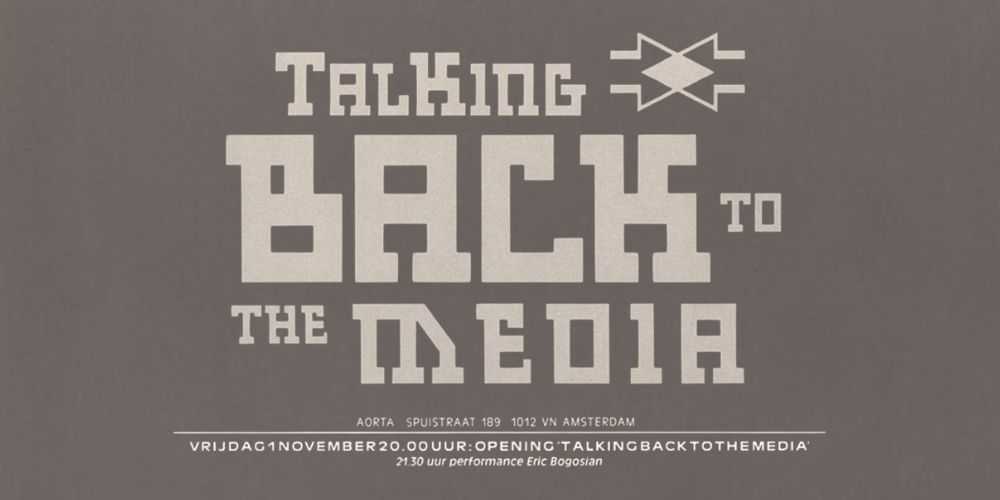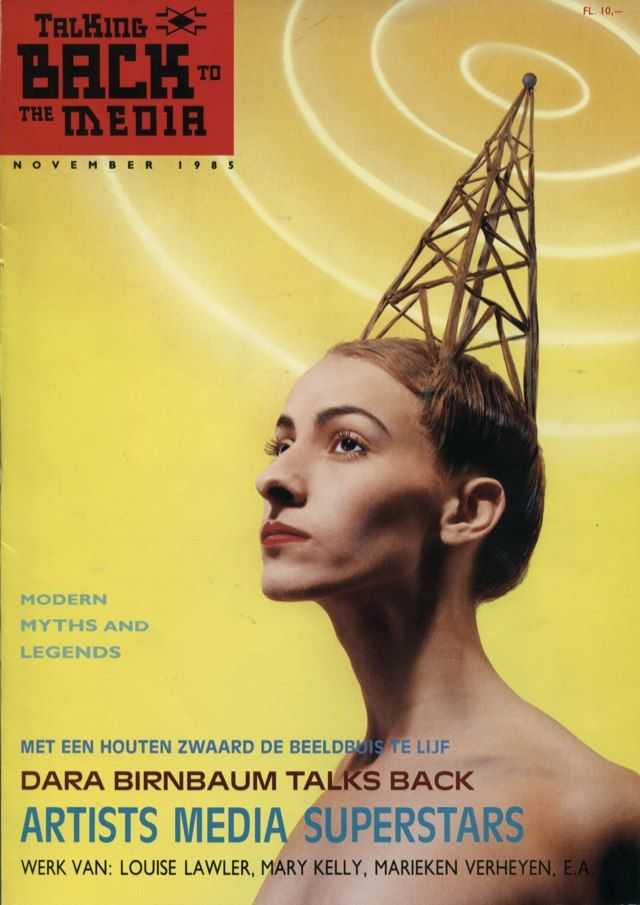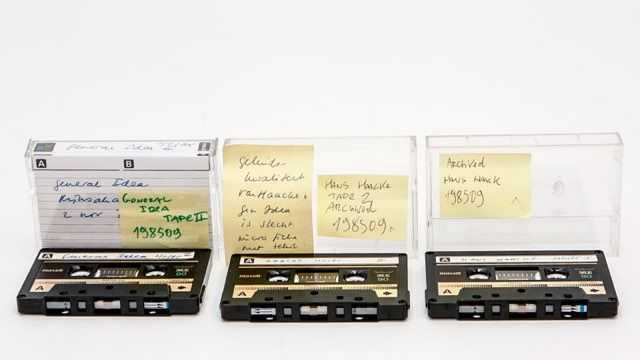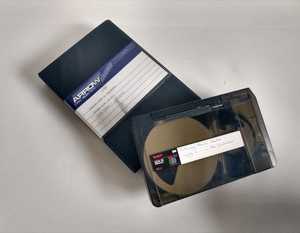
12½ Years LI-MA: Artists Talking Back to the Media
Challenging mass media through performance, video, and critical discourse
In the mid-1980s, a bold experiment unfolded across the cultural landscape of Amsterdam. Artists Talking Back to the Media was an artist-led manifestation that brought together some of the most incisive voices in media art, whose interventions questioned the ideological machinery of mass media and explored how artists could speak back to it, visually, critically, and politically.
Against the backdrop of an increasingly pervasive mass media landscape, a group of artists and cultural institutions came together in Amsterdam to launch Talking Back to the Media. Conceived by artists David Garcia and Raul Marroquín and developed with figures such as Ulises Carrión, Max Bruinsma, Rob Perrée and Sabrina Kamstra, the project challenged the dominant narratives of mass communication through a constellation of artistic interventions across the city.
The initiative brought together media artists who blurred the boundaries between performance, broadcasting, visual art, and activism, prefiguring many of the participatory, critical, and hybrid forms that media art would take in the decades to come.
Decades later, LI-MA and de Appel revisited this pioneering moment in media art history. Through in-depth archival research, digitisation, and artist interviews, a new lens was cast on this formative event, uncovering its influence on critical media practices and the infrastructures that support them.
As part of our ongoing series highlighting milestones from LI-MA’s 12½-year journey, Talking Back to the Media stands out as a defining moment. This 1980s artist-led initiative challenged mass media’s grip on public imagination and helped shape the critical media art practices that continue to inspire LI-MA’s mission today. For director Gaby Wijers, revisiting this project is a personal highlight. Those early interventions laid the groundwork for LI-MA’s ongoing commitment to media art as a form of cultural resistance and critical dialogue.

Talking Back to the Media magazine. Publisher de Appel, Amsterdam, 1985
What Was Talking Back to the Media?
Talking Back to the Media was not a single exhibition or event, but a networked manifestation of artistic resistance. Spanning commissioned works, photography exhibitions, artist talks, theatre, film, a dedicated publication, and television broadcasts, it mobilised the city of Amsterdam as a platform for critique. Key partners included Aorta, de Appel, Kriterion, Shaffy Theater, Time Based Arts, and VPRO radio.
For Amsterdam in 1985, Talking Back to the Media was perfectly situated. As co-initiator David Garcia noted, the city’s unique scale allowed for hyperlocal experimentation with a global echo:
The concept is developed by Aart van Barneveld, Max Bruinsma, Ulises Carrión, David Garcia, Sabrina Kamstra, Sebastián López, Raul Marroquín, Rob Perrée and Marijke de Vos, all of whom confronted mass media's grip on public imagination through irony, satire, and direct deconstruction.
As stated in the original editorial from the 1985 publication:

Hans Haacke -Talking Back to the Media – nr 1 and nr 2 – lecture. Source: de Appel
One of the central figures in this context is Dara Birnbaum (1946–2025), whose essay "Talking Back to the Media" was originally written for the 1985 festival and has recently been republished in tribute to her work and legacy. Birnbaum was among the first artists to systematically deconstruct the visual grammar of television by employing repetition, fragmentation, and musical overlays to reveal underlying ideologies, particularly around gender and power. Link to essay?
In her essay, Birnbaum describes her early video practice as a form of “talking back” to a medium that typically operates in one direction. By appropriating television footage and interrupting its flow, she aimed to slow down the “technological speed” of broadcast imagery and open space for reflection. She called these interventions “new ready-mades” for the late 20th century, displaced fragments that encouraged active viewing and critical analysis.
Archival Research: Mapping a Fragmented History
Between 2013 and 2014, LI-MA and de Appel undertook the task of rediscovering and reactivating the archives of Talking Back to the Media. Brigitte Bélanger and Camie Karstanje were instrumental in mapping the project's dispersed legacy, beginning with a comprehensive inventory of all documents, video materials, artist files, correspondence, and press coverage from 1985.
Their research traversed multiple institutions: de Appel’s archive offered insight into curatorial strategies and contextual frameworks, while LI-MA’s video archive preserved highlights from exhibitions and commissioned works. One surprising discovery came from Kriterion, whose records were traced to the International Institute of Social History.
Alongside archival research, the team conducted interviews with original participants, capturing personal recollections that helped piece together the event’s conceptual and practical development. These interviews, together with digitised materials, stills, and transcripts, have been compiled into a research report available on request via LI-MA or de Appel.
Decades later, as the conditions of media production and consumption have shifted but not diminished in influence, this perspective remains relevant. Whereas in the 1970s and 1980s access to broadcast footage was limited, contemporary artists work within a context of digital abundance. Yet the challenge remains the same: how to reclaim agency within a highly mediated environment.
One of the foci In LI-MA’s collection is media activism and the role of media art in shaping critical discourse, bringing together historical and contemporary works that examine the aesthetics of protest, representation, and public space. The collection includes a selection of works from artists spanning the past four decades, including Lydia Schouten, General Idea, and Donna Verheijden. These works offer a vivid timeline of media-based activism and artistic reflection, tracing a lineage that extends from the media critiques of the 1980s to today’s nuanced explorations of surveillance, gender, identity, and digital culture.
Artists Talking Back to the Media served as a timely reminder of how artists have long questioned, subverted, and transformed the mechanisms of mass communication – and how those interventions continue to evolve. The project’s hybrid and participatory forms resonate deeply with LI-MA’s vision of media art as a living, evolving field that benefits from collaborative knowledge exchange and community engagement. In revisiting Talking Back to the Media, we are invited not only to reflect on the past but also to imagine new futures for media-critical art practice.
Through the combined efforts of LI-MA and de Appel, this distributed archive has been reassembled, not as a static record, but as an evolving resource that continues to inform contemporary conversations on art, media, and activism.
Support LI-MA, and become part of this vital work to preserve and amplify media art for generations to come.








